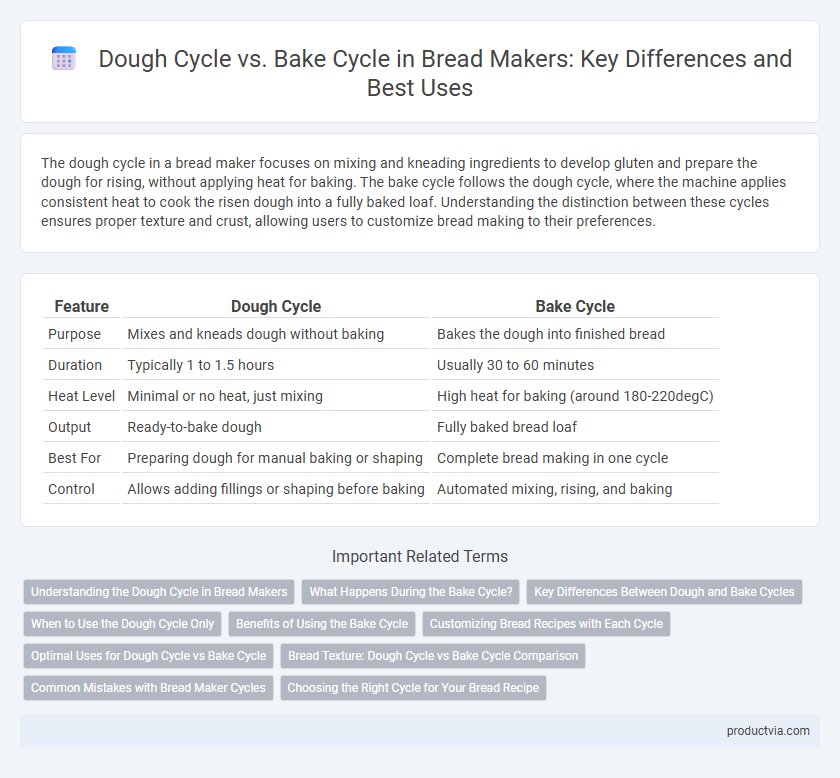The dough cycle in a bread maker focuses on mixing and kneading ingredients to develop gluten and prepare the dough for rising, without applying heat for baking. The bake cycle follows the dough cycle, where the machine applies consistent heat to cook the risen dough into a fully baked loaf. Understanding the distinction between these cycles ensures proper texture and crust, allowing users to customize bread making to their preferences.
Table of Comparison
| Feature | Dough Cycle | Bake Cycle |
|---|---|---|
| Purpose | Mixes and kneads dough without baking | Bakes the dough into finished bread |
| Duration | Typically 1 to 1.5 hours | Usually 30 to 60 minutes |
| Heat Level | Minimal or no heat, just mixing | High heat for baking (around 180-220degC) |
| Output | Ready-to-bake dough | Fully baked bread loaf |
| Best For | Preparing dough for manual baking or shaping | Complete bread making in one cycle |
| Control | Allows adding fillings or shaping before baking | Automated mixing, rising, and baking |
Understanding the Dough Cycle in Bread Makers
The dough cycle in bread makers focuses exclusively on mixing, kneading, and allowing the dough to rise without baking, providing users the flexibility to shape and bake bread manually or use the appliance's baking cycle later. This cycle is essential for recipes requiring a delicate fermentation process or incorporating additional ingredients after rising. Understanding the dough cycle enhances control over the bread-making process and improves final bread texture and flavor.
What Happens During the Bake Cycle?
During the bake cycle of a bread maker, the dough is exposed to a controlled heat environment that activates yeast fermentation and causes the dough to rise and set. The internal temperature gradually increases to cook the bread evenly, developing a golden crust and a soft, airy crumb. This phase ensures the bread maintains its structure and flavor, completing the transformation from raw dough to fully baked loaf.
Key Differences Between Dough and Bake Cycles
The dough cycle in a bread maker focuses on mixing and kneading ingredients to develop gluten and form a smooth, elastic dough, excluding baking. The bake cycle applies heat to the dough, causing it to rise further and bake into a finished loaf with a golden crust and soft crumb. Key differences include the dough cycle's emphasis on preparation and fermentation, while the bake cycle centers on cooking and crust formation.
When to Use the Dough Cycle Only
The dough cycle in a bread maker is ideal when you want to prepare dough without baking it, allowing for manual shaping or adding extra ingredients before baking. Use the dough cycle only when making pizza dough, dinner rolls, or artisan breads that require hand shaping or a second rise. This cycle kneads and proof the dough perfectly, giving you control over the final texture and crust.
Benefits of Using the Bake Cycle
The bake cycle in a bread maker ensures optimal crust formation and even browning, delivering a perfect texture and flavor that the dough cycle alone cannot achieve. It allows the dough to fully develop gluten structure during the rise and then bakes the bread at precise temperatures for consistent results. Using the bake cycle enhances bread quality by providing uniform heat distribution, resulting in a professional finish and longer freshness.
Customizing Bread Recipes with Each Cycle
The dough cycle in a bread maker allows precise control over mixing, kneading, and fermentation, enabling customization of texture and rise before baking. The bake cycle focuses solely on baking the prepared dough, providing flexibility to use pre-made dough or adjust baking time and temperature for crust preferences. Mastering each cycle enhances the ability to tailor bread recipes to specific tastes and dietary requirements.
Optimal Uses for Dough Cycle vs Bake Cycle
The dough cycle in a bread maker is optimal for preparing and kneading dough, allowing users to shape and customize their bread with homemade additions before baking separately, ensuring precise texture control. The bake cycle is ideal for fully automated bread making, where the machine handles both kneading and baking, delivering consistent, ready-to-eat loaves with minimal user intervention. Choosing the dough cycle enables greater flexibility for artisan bread styles, while the bake cycle prioritizes convenience and time efficiency in bread production.
Bread Texture: Dough Cycle vs Bake Cycle Comparison
The dough cycle in a bread maker prepares the dough by mixing and allowing it to rise, resulting in a lighter, airier bread texture that is ideal for artisan-style loaves or rolls. In contrast, the bake cycle applies heat to cook the dough, creating a firm crust and a denser, more structured crumb perfect for traditional sandwich bread. Understanding the distinction between these cycles helps optimize bread texture based on desired moisture, crumb softness, and crust thickness.
Common Mistakes with Bread Maker Cycles
Many users mistakenly interrupt the dough cycle before it finishes, resulting in under-developed gluten and uneven texture. Another frequent error is starting the bake cycle immediately after the dough cycle without allowing proper proofing, which can cause dense or poorly risen bread. Misunderstanding the differences between kneading, rising, and baking phases leads to inconsistent outcomes and affects the overall quality of homemade bread.
Choosing the Right Cycle for Your Bread Recipe
Selecting the right cycle on a bread maker significantly impacts the texture and taste of your bread. The dough cycle is ideal for preparing pizza dough or bread to be shaped and baked manually, allowing for custom baking techniques. The bake cycle, on the other hand, handles both kneading and baking automatically, providing convenience and consistent results for various bread recipes.
Dough cycle vs bake cycle for bread maker Infographic

 productvia.com
productvia.com